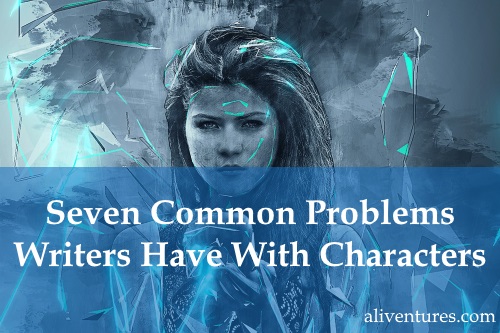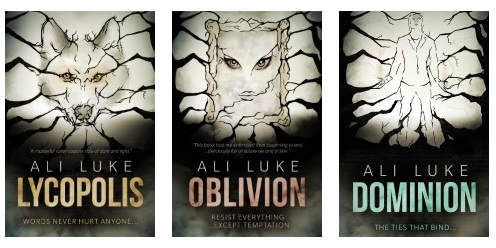Seven Common Problems Writers Have With Characters

Most writers love creating characters and writing about them – but it can be a struggle to get characters right.
If you’re normally quite plot-focused, you might find yourself creating characters who are lifeless “pegs” that fit into the right-shaped spaces in your plot.
If you’re much more character-focused, you might struggle with the size of your cast (more isn’t always better!) … or you might find it really difficult to let your characters suffer and struggle.
In today’s post, we’re going to look at seven common problems that writers struggle with … and some ways to get past them.
Problem #1: Creating Characters Who Are Three-Dimensional
If you’ve been writing fiction for a while, you’ve probably come across the advice to avoid writing “flat” or “two-dimensional” characters. These are characters who don’t really seem to come alive. They might seem a bit boring, thin, or shallow to the reader: there’s no real depth to them.
This can be a tricky issue to spot in your own writing – but if you’ve been told that your characters seem “flat” or unengaging, or if you suspect that characterisation isn’t your strong point, you might want to:
- Spend some time really thinking about your characters. Who are they, deep down? What’s happened in their past that’s shaped them? How have the events of your novel impacted them?
- Let your characters have moments when they act in ways the reader doesn’t expect. Maybe your sweet, nice protagonist gets pushed too far and shouts at someone; maybe your grumpy mentor figure shows their kindly side.
- Show your character changing throughout your story. Perhaps your protagonist really is shallow and boring at the start of your novel – but the things that happen to them, and their reactions, lead them to grow as a person.
Not all characters need to be well-rounded, of course. Characters who only appear briefly and aren’t important to the plot shouldn’t be too fleshed-out (or your reader will start to think that the taxi driver or waitress or bank manager are more important to the plot than they actually are). In some genres, too, flat characters make sense: comic characters might be known for one or two funny or exaggerated characteristics, and don’t necessarily need to be rounded out.
Further Reading: Three-Dimensional Characters: 3 Ways to Create One, Writes With Tools
Problem #2: Juggling a Cast of Multiple Characters
Some stories have a tight, focused cast of characters – but others are sprawling epics. (Game of Thrones, anyone?)
If you’ve got lots of characters – particularly lots of main or viewpoint characters – then it can get tricky for your reader to keep track of everyone. It can also create problems with the reader’s engagement: perhaps they really enjoy reading about two of your characters, but they’re not very interested in the other six that you keep bringing in.
To thin down your cast a little, it’s worth asking yourself whether you really need so many characters. Do you have to bring in two brothers for your protagonist, or would one be enough? Does that grumpy woman who lives down the hall have any real impact on the plot?
Walk-on parts don’t count here. No-one’s going to be bothered by you having a taxi driver to get your characters from A to B, or a bartender to serve them, or a cashier at the bank to tell them they’re overdrawn. Avoid naming these characters, and readers will assume they won’t recur (and thus won’t need keeping track of).
If you do need to stick with lots of characters, it helps to:
- Introduce them in small batches. Don’t open your novel with a huge party scene where you introduce all ten of your key characters – the reader’s going to end up confused and overwhelmed.
- Group them together in some way. It can be easier for readers to remember and keep track of characters if they’re partnered up or in small groups (e.g. perhaps a married couple, a family unit, colleagues, and so on).
- Give a bit more information when characters reappear than you normally would – e.g. you might need to remind us that Jason is Sarah’s colleague, for instance, or have characters referring back to the incident that was taking place in the last scene in which we saw them.
Further reading: The 10 Rules of Writing Large Casts of Characters, K.M. Weiland, Helping Writers Become Authors
Problem #3: Letting Characters Solve Their Own Problems
This is can be more of a plot issue than a character one, in terms of your writing. If your plot involves your characters being rescued by coincidence, an outside force, or someone who isn’t in your main cast, then your readers will feel frustrated or even cheated.
This is particularly true at the ending of your story. We want characters to earn their happy ending: we don’t want the hero to succeed simply because the (normally competent) villain makes a blindingly stupid mistake.
If your characters are constantly being rescued by other people, or if their successes rely on a change of coincidences, look for ways to let them solve their problems through their own strength or wit.
This problem might be related to the next one, too, if you hate to let your characters struggle.
Further reading: How to correctly use a “Deus-Ex-Machina” and not die trying, Duilio Giordano Faillaci, Medium
Problem #4: Making Bad Things Happen to Your Characters
Without your characters facing problems … there’s not much of a story. Your main characters, particularly your protagonist, need to go through some difficult, sad, or downright painful events.
Depending on your genre, this could mean a lot of different things. The heroine in a romance might not suffer any physical injuries – but she might well be upset or hurt by a love interest, or might be distressed by a broken-off engagement.
In many genres, there’ll be all sorts of bad things that happen to your characters. They might be hunted by a serial killer (crime), they might be haunted by something strange and inexplicable that’s happening to them (mystery), or they might be running for their life or trying to save the world (adventure).
As a writer, it can be difficult to allow anything bad to happen to your characters. Remember, though, that if your characters effortlessly sail through the story without any sort of upset or harm, readers aren’t going to find it particularly engaging.
Let your characters get hurt, let them be miserable, and especially let them face up to the consequences of their actions.
Further reading: Making Bad Things Happen to Good Characters, Ali Luke, Aliventures
Problem #5: Giving Characters Realistic Flaws
I hinted at this in the last section: your characters, even the good ones, should have flaws that cause them to do things that complicate the story for them. This can often be a core part of your character’s growth.
If you have an irritable protagonist with a hair-trigger temper, perhaps they snap at their best friend one too many times … and their friend stops speaking to them.
If you have a character who’s a daring adrenalin-seeker, perhaps something goes wrong with their motorcycle stunt – and they get hurt. (Or worse, someone else does.)
Flaws also make your characters more realistic, and they help us empathise with them. Characters who are too perfect are usually two-dimensional (see #1) and they can be annoying or just hard to engage with.
Further reading: How to Craft Brilliant Flawed Characters (a #StorySocial recap), Kreisten Kieffer, Well-Storied
Problem #6: Allowing Characters to Strive for a Goal
Your characters, particularly your protagonist, should have a goal that they’re trying to achieve. This might be something fairly small – and, if something bad has happened right at the start of the novel, it might simply involve returning to the status quo.
Often, your character’s initial goal isn’t the one they’ll end up striving toward during the rest of your novel. Perhaps they’re chasing a promotion at work, or trying to pass an exam, or preparing for a trip abroad. Their goal might be ditched or superseded by the events of the plot (e.g. the exam suddenly seems much less important when the person they love most falls mysteriously ill, and doctors are at a loss to help).
Make sure your character has something that they want to achieve (or to avoid – e.g. getting fired) right from the start of your story. This helps us to root for them – and encourages us to keep reading to see whether they get the thing they want.
Further reading: Most Common Writing Mistakes: Characters Who Lack Solid Story Goals, K.M. Weiland, Helping Writers Become Authors
Problem #7: Reining Characters In
Finally, this is a problem that some writers can have – particularly those who don’t tend to create an outline. (Not that I’m knocking that: my first drafts are very exploratory and I pretty much never have a full-blown outline in place.)
Some writers feel that their characters “take over” or “come alive” and send scenes spiralling off in unexpected directions. While that can be a fun way to write – and potentially a great way to come up with new ideas or plot twists – it can also end up with your scenes devolving into a bit of a meandering mess.
If you feel that your characters take over in this way, it’s worth drawing a clear distinction between bits of writing you’re doing that are intended to be exploratory, and bits that are part of the plot. Maybe you have a rough draft of a scene where your protagonist goes off in a direction you really didn’t plan – that doesn’t mean you have to stick with it!
If it becomes clear that your original plan wouldn’t be in keeping with your character’s personality, then you might need to look for ways to nudge them back onto the “right” path. This could mean throwing extra complications into the mix – either to prod them toward further action (if your characters mostly like to sit around, drink tea, and have a nice chat) or to rein them in (if your characters tend to do outlandish things that are hard to come back from).
Further reading: When Characters Go Their Own Way, Juliet Marillier, Writer Unboxed
Getting characters right can be really hard – but also very much worthwhile. I’m sure you can think of characters who’ve stuck with you for years after you read about them – characters who you loved like friends.

For more on creating and writing characters, check out the other pieces so far in our four-week series:
#1: Five Different Approaches to Developing Characters (blog post)
#2: How Much Should You Describe Your Characters? (newsletter)
#3: Making Bad Things Happen to Good Characters (blog post)
#4: Five Ways to Establish Sympathy for Not-So-Nice Characters (newsletter)
You might also want to check out my “Advanced Fiction” self-study pack, which has three seminars relating to characters (Heroes & Villains; Handling Viewpoint in Fiction; Seven Ways to Add Depth to Your Characters).
You can find all the details of that, and my other self-study packs, here.
About

I’m Ali Luke, and I live in Leeds in the UK with my husband and two children.
Aliventures is where I help you master the art, craft and business of writing.
Start Here
If you're new, welcome! These posts are good ones to start with:
Can You Call Yourself a “Writer” if You’re Not Currently Writing?
The Three Stages of Editing (and Nine Handy Do-it-Yourself Tips)
My Novels

My contemporary fantasy trilogy is available from Amazon. The books follow on from one another, so read Lycopolis first.
You can buy them all from Amazon, or read them FREE in Kindle Unlimited.


This is a great post for authors who focus on fiction. Though I am not a fictional author, I find a lot of value from your posts.
It would be great if you can provide some tips or write a post on using characters for business writing.
I have made an attempt on https://productiveclub.com/long-term-goals-setting/. If you could read through it and tell me 1 thing I could improve with my writing, you will make my day.
Maxim Dsouza’s last blog post ..How focusing on multiple tasks kills your concentration
Thanks Maxim! I’m not really focused on business writing here on Aliventures, but I know the kind of technique you mean (and I can see you’re using it in your post with Chris, Samantha and Norman — I like the cute graphics)!
Thanks a lot for taking the time to respond. Even though you are not keen on writing about business writing, I do find a lot of value in your articles. I just need to translate some of your ideas into business writing. Thanks again.
No problem! You might like the site http://www.dailywritingtips.com, if you don’t already read that one — they cover a lot of different aspects of writing, and I write for them from time to time.